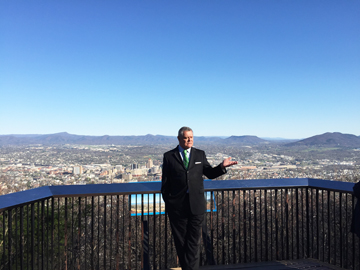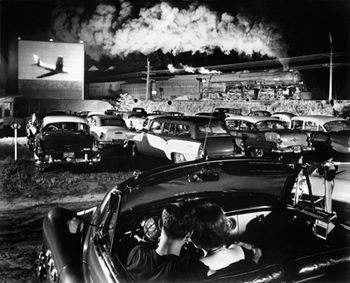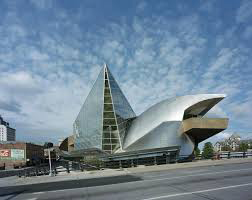Travel and Culture: Roanoke, VA: Music, History, Folklore, Fine Art and Craft
By Cornelia Seckel
ART TIMES mid-August 2016
 David A. Bowers, Mayor of Roanoke speaks to the journalists at the Roanoke Star and Overlook |
What comes to mind when you think of Virginia? For me, I think about the Blue Ridge Parkway that goes along the Blue Ridge, a mountain chain that is part of the Appalachian Mountains. This is the longest linear park (469 miles) in the US and the most visited park except for in 1949 & 2013 (but not sure why). I also think of quilts and other early American crafts, the Clock Tower of the Richmond Main Street Train Station as I’d drive along route 95 enroute to Florida and the most gorgeous views of the Appalachian Mountains.
I was pleased to be invited on a press trip to Roanoke Virginia where over several days we visited among other things numerous artists’ studios, historic sites and museums and of course learned about trains. Traveling with a group of other writers is fun. People ask questions I wouldn’t think to ask and friendships develop.
David A. Bowers, Mayor of Roanoke met us at the Roanoke Star and Overlook, an historic landmark that provides a fabulous view of the city. Roanoke is located in the valley immediately west of the Blue Ridge Mountains and east of the Allegheny Mountains. It has been a crossroads since Indian days when people used buffalo trails through the valley as hunting and fighting ways. Salt licks at the valley's heart drew animals, and Indians to hunt them. With settlement by the white man in the mid-1700's, roads followed the buffalo trails, one, known as the Great Road, north and south; the other, called the Wilderness Road, east and west. A farming community developed, with a tiny village in the center called Big Lick in reference to the salt licks near by. The completion of the Shenandoah Valley Railroad from Hagerstown, Maryland, to its junction with the newly formed Norfolk and Western Railway in 1882, marked the start of Roanoke's rapid growth. Mayor Bowers spoke passionately about his city and the great diversity of the population (105 different nationalities). There are 60 languages spoken amongst 100,000 people. He spoke of the cosmopolitan feel of the city and that as a result of their excellent Superintendant of schools the graduation rate is now up to 86%— up from 59% from when he began. The Carilion Clinic of the Medical School from Virginia Tech is a brain injury research center and a leading economic drive and great supporter of the arts.
 Ask the Fish 2.0 by Stephen Fairfield in Elmwood Park |
We started out day one with a walking tour of the public art centered primarily in Elmwood Park. The work is engaging and the park has a large amphitheatre and performance program. Roanoke has an active Arts & Culture program and, among many other things holds a competition for this outdoor sculpture show. This year the People’s Choice Award was given to “Ask the Fish 2.0” by Stephen Fairfield who also received a $1,000 honorarium.
Roanoke has a very fine Symphony Orchestra (RSO), one of the oldest cultural groups in Roanoke, and music director and conductor David Stewart Wiley spoke with us about some of the reasons for the success and popularity of the Orchestra. They have brought audiences a fusion of Classical and Bluegrass and a diverse list of guest artists. They do a lot of outreach to the community and have a partnership with the schools working with the school band, chorus and orchestra. David Wiley, a delightful spokesperson for RSO, is a solo pianist and has performed across the country; this is his 20th year with RSO. www.rso.com
 photo taken at the museum of O. Winston Link and his elaborate equipment to photograph at night |
We headed over to the O. Winston Link Museum (housed in a former passenger station of the Norfolk & Western RR) dedicated to the photographer Winston Link whose photographs captured the history and last days of the steam locomotive. The Norfolk & Western Railroad, headquartered in Roanoke, was the last company to operate steam locomotives. At the Virginia Museum of Transportation the Norfolk & Western Class J 611 (http://fireup611.org/) is on display through Labor Day and it was possible to book a ride (contact them for 2017). Their rail yard, explores historic steam and diesel engines, cabooses, and other rail equipment. Inside the Museum (housed in a former freight depot), visitors can enjoy model trains and hands-on exhibits, stroll among the antique automobiles, and explore the truck, bus, and aviation exhibits.
The content and composition of O. Winston Link photographs and that he was a master of lighting makes him one of the most exciting and fine photographers I have seen. It is said that he had the eye of an artist and mind of an engineer. He pioneered night photography. He believed that it was more romantic and dramatic and that steam from the trains against a night sky photographed white. Against a day sky it came out a dirty grey.
 Hotshot Eastbound (1956), taken at the drive-in theater in Iaeger, West Virginia, was used in Link's book Steam, Steel & Stars. This is one of Link's best-known photographs |
He documented, both in photographs and in sound recordings, the last days of steam locomotive railroading on the Norfolk & Western line in the United States in the late 1950s and the communities along the rail. His recording supported his film. It was not until he had a traveling exhibition in 1983 that his work was brought to a wider public. He died in 2001 at the age of 86 of a heart attack outside a train station in Katonah, NY.
There is some justice in the world: In 1996, Link's second wife, Conchita, was arrested for (and later convicted of) stealing a collection of Link's photographs and attempting to sell them, claiming that Link had Alzheimer's disease and that she had power of attorney. She served six years in prison. When she was released she again attempted to sell some of Link's works that she had stolen, this time using the Internet auction site eBay. She received a three-year sentence. There is more information, images and a powerful film about Links available at www.linkmuseum.org/
 The Taubman Museum designed by Randall Stout |
The Taubman Museum of Art (taubmanmuseum.org) began as the Roanoke Fine Arts Center (work was shown in a hotel) before it became the Art Museum of Western
Virginia. Now, 64 years later the museum is housed in a building designed by Randall Stout and opened as the Taubman Museum of Art in 2008. It is a
beautiful building and one that reflects the natural elements of the Roanoke region. An excellent description and photographs of the building can be seen
at http://bit.ly/2bcM5QP
While we were at the museum a travelling exhibit “American Chronicles: The Art of Norman Rockwell” was on view. I had seen so many of the works included in the exhibit since I’d been to The Norman Rockwell Museum in Stockbridge, MA a number of times. The last time I was there I was looking for the collection of Saturday Evening Post covers (323 of them) and they were out on tour. I liked seeing these familiar works (some I’d reprinted in ART TIMES when Raymond wrote about Norman Rockwell in August 2001).
Norman Rockwell Saturday Evening Post covers |
The Museum has 11 galleries on the 2nd floor which originates 15-20 exhibitions per year and is home to a permanent collection totaling around 2,155 pieces. The collection includes: American, Southeast American Contemporary, Folk, Regional and Visionary artwork featuring the work of artists such as Thomas Cowperthwaite Eakins (whose wife was from Roanoke), John Singer Sargent, Purvis Young, Petah Coyne and John Cage. Major events sponsored by the museum include an International Wine Festival, Monster Art Rally and Sidewalk Art Show.
These are just a few of the upcoming exhibitions at the museum:
• Legacies
Honoring Artistic Luminaries from Southwestern Virginia.
The artists represented highlight the very best of the community from the 1800s to the recent past. August 27– January 28, 2017
• Happy Birthday, Howard!
The Amazing World of the Reverend Howard Finster
honoring Howard Finster’s (1916-2001) 100th birthday, focuses on the artistic output of outsider artist, the Reverend Howard Finster. September 17, 2016 –
January 15, 2017
• Follicular
The Hair Stories of Sonya Clark
known for using human hair and combs, Afro-American multi-media artist Sonya Clark addresses the origins of craft, race, culture, class and history in her
work in installations and performance. Oct 1 2016- Jan 17, 2017
A group of us explored several of the galleries located in Roanoke’s downtown. There are 15 galleries that participate in the 1st Friday Art By Night when the galleries, shops and restaurants are open. The Market Gallery (marketgalleryroanoke.com) is a cooperative with between 30-35 members. Sixteen years ago, in 2000, they opened because there were no galleries downtown. The Wilson Hughes Gallery (www.wilsonhughesgallery.com) shows international artists and also Suzun Hughes & John Wilson’s work. They hold 3 shows each year. Collectors Linda and Dorsey Taylor own LinDor Arts (www.FB.com/LinDorArts) and show about 30 artists’ work, some emerging, others well established with styles and mediums quite varied. The Aurora Studio Center (aurorastudiocenter.com) provides rental spaces for artists, dance studios, art classes and space for workshops, meet-ups, gatherings and classes. Periodically they have a pop up gallery— a 2 day art event where artists and craftspeople set up displays to show and sell their work.
Robert Kulp talking about his company Black Dog Salvage |
Black Dog Salvage (www.blackdogsalvage.com) is, as their brochure says, a treasury of antiques and architectural relics awaiting discovery. Robert Kulp and Mike Whiteside reclaim and renew/ repurpose salvage. That it is their passion is evident as I wandered around the huge 40,000 sq foot warehouse. They have been at it since 1999 and have a ½ hour TV show on Netflix, now filming it’s 7th season, showing the demolition and the repurposing of great finds. The idea of reclaiming buildings and items that no longer can function as originally made is not only blossoming in this country but I’ve seen it in Europe and Asia as well.
The next day we headed out to the rolling hills of Botetourt County just north of Roanoke. We visited several painters and craftsmen including oil painter Mark Young, Kevin Riddle woodworker and coppersmithing, printmaker Ed Bordett, wood turner Willie Simmons and Jake Cress, master craftsman of animated wood furniture.
Our time at The Blue Ridge Institute and Farm Museum at Ferrum College, the official state center for Blue Ridge Folklore, was wet and enjoyable. Costumed
interpreters gave us a tour of the reconstructed farm from 1800’s. The farmhouse was inhabited until 1950. The institute has an annual Folklife Festival,
an extensive outreach program for schools and the community and among many other things they maintain the Blue Ridge Heritage Archive of photographs, audio
and video recordings, manuscripts and other documents from 1780’s to the present. (blueridgeinstitute.org)
 (l) visitors viewing the Crooked Road exhibit (r) some of the buildings and unplanted garden at The Blue Ridge Institute and Farm Museum at Ferrum College |
There was a regional folk art exhibit, and exhibit about the Musical styles along the Crooked Road, Virginia’s Music Trail. From the fact sheet: “The Crooked Road” is Virginia's Heritage Music Trail, a 330 mile driving route through the Appalachian Mountains of Southwest Virginia. From the eastern slopes of the Blue Ridge to the Coalfield region of Virginia, the trail connects eight major heritage music venues with a thriving network of jams, festivals, and concerts in the communities along the way. America's music was invented here. It has been made for hundreds of years in the southern Appalachian mountain region of Southwest Virginia. The songs and tunes of the region told the stories of early pioneer life, of immigrant experiences, and of day-to-day trials and tribulations. The influences that are felt in the music come from many traditions. The ballads of the early Scots-Irish and settlers of the British Isles are evident, as are their instruments, such as the fiddle. The blues and work songs of laborers of African heritage are also evident, along with instruments such as the banjo. The mountain dulcimer and the autoharp have connections to the zithers of European ancestry, while the ukulele and the guitar were popular parlor instruments. Some of the highlights of the music trail include the Ralph Stanley Museum, The Carter Family Fold, Blue Ridge Music Center, and since 1935, Galax has hosted the Old Fiddler's Convention, Friday jamboree at the The Floyd Country Store, and the Blue Ridge Institute and Farm Museum, Ferrum. The website www.thecrookedroad.org has details for the nine major venues, over 60 affiliated venues and festivals and 25 wayside exhibits that one can explores along the trail where America’s music was born and continues to live.
Rocky Mount Center for the Arts |
Demonstration of glass blowing in the 2300˙ glory hole |
We saw a demonstration of glass blowing in the 2300˙ glory hole when we visited The Rocky Mount Center for the Arts, a non-profit organization that promotes fine art and high craft in rural Virginia. They work with The Grainery, which has art studios, classes and galleries and extensive shop with work for select artists and artisans. The RMCA also works to fund public art projects in the area, and maintains a scholarship fund that helps the under-served members of the community.
Roanoke is just 3 miles from the Blue Ridge Parkway and has 14 miles of trails, an excellent park, zoo and wildflower garden. This beautiful part of Virginia is filled with history, music, folklore, crafts and fine art. Virginia isn’t just for lovers— it’s for everyone.
Share |
